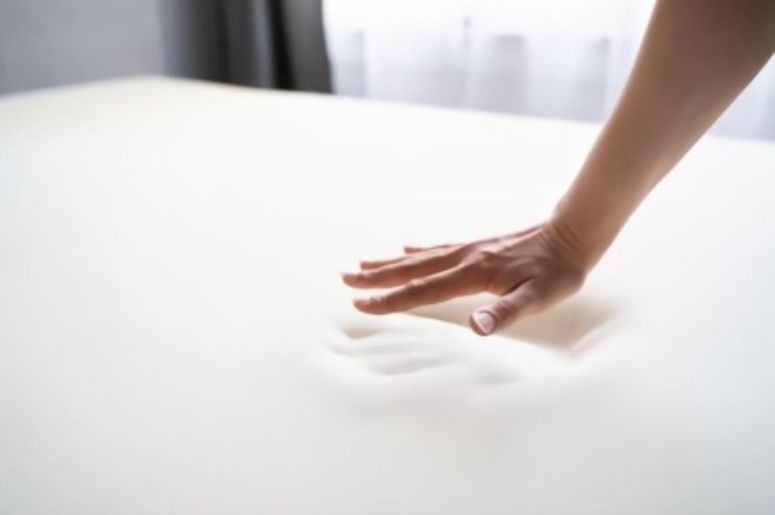A memory foam mattress is a type of mattress made up of a combined layer of memory foam with springs or support foam. It works by using body heat to soften and mold itself to fit your shape.
Memory foam will gradually return to original shape once pressure is released from it.
Over time, it will begin to remember your natural body structure during sleep and optimal sleep position, thus the term memory foam.
Just like its name suggest, ‘memory’ foam is about the mattress ‘remembering’ something, which in this case is your body shape.
Visco-Elastic
The phrase ‘viscoelastic’ is not widely used in common language. But another term for memory foam is viscoelastic foam. The technique of producing viscoelastic foam differs based on the mattress manufacturer.
The properties of the foam alter depending on the composition.
Some kinds of viscoelastic foams, for example, may be more resistant to changes in the shape of a body lying on them. It may take longer to mold to a person’s particular form.
Visco foam is a thick and solid material. As a result, most substances are unable to enter through the surface. The foam, on the other hand, displays significant elastic qualities.

For the past 50 years, viscoelastic foam has been in existence. In fact, NASA created it as a material that would have been utilized to keep astronauts comfortable and safe during spacecraft launch. People enjoyed it so much that it began to be utilized in more and more places, and when Tempurpedic developed its memory foam mattress, it grew in popularity. You can now find it in cushions, pillows, and even shoes now.
What is Memory Foam Mattress Made of?
Memory foam mattress is made of polyurethane and other chemicals that increase its density. The foam is also called ‘viscoelastic’ polyurethane foam because it is a polymer of plastic used in products such as hoses.
Today, memory foam is used in many other products, contrary to the past when only NASA’s aircraft cushions had them.
The intelligent molding features of the foam makes it ideal for making comfortable mattresses.
Despite the seemingly smart nature of memory foam, there are concerns that it could be bad because it is made from heavy industrial chemicals. Some of these chemicals causing trust problems include isocyanates that could cause skin irritation and other health complication.
Companies that Make Memory Foam Mattresses
These are some of the common examples memory foam mattress brands:
- Nectar Mattress
- Layla Memory Foam Mattress
- Saatva Loom and Leaf Memory Foam Mattress
- Zinus Green Tea
- Helix Midnight Memory Foam
- Zoma Mattress
- Lucid 10-Inch Gel Memory Foam Mattress
- Leesa Hybrid
- Tempurpedic Tempur-Adapt
- WinkBeds GravityLux
Memory foam mattresses provide a lots of benefits over other types of mattresses. Manufacturers design these mattresses to provide optimal comfort and care for you as you sleep, from pressure relief to individualized support.
How long does a memory foam mattress last?
Memory foam mattresses can last 7-10 years. However, the lifespan of a memory foam mattress could vary depending on quality of foam used and how well you care for it. A memory foam mattress can outlast the National Bed Federation’s recommended seven-year lifespan in terms of support and durability.
For health and sanitary reasons, I would recommend replacing your memory foam mattress every seven years. Although dust mites cannot penetrate the structure of a memory foam mattress, they could build up on the surface over the course of seven years. Your bedroom needs to remain clean, fresh, and hygienic if you want to replace your mattress every seven years.
Mattress experts also recommend using a mattress protector to help extend the life of your memory foam mattress and keep dust mites away for a long time.
Benefits of a memory foam mattress
- Optimal support and comfort due to personalized alignment of the body
- Reduces transfer of movement
- Memory foam mattresses provide pressure-point relief
- Memory foam is dust mite resistant
- Good for people with arthritis and joint pain because the mattress relieves pain
- Great for individuals with allergies
When Should You Replace Memory Foam Mattress?
When it comes to changing your mattress, there are a few indications you need to look out for.
While a decent memory foam mattress should last seven to ten years, it’s crucial to keep an eye out for these possible issues because lower-quality foam can wear out much more quickly.
If you see visible sagging or that impressions stay considerably longer than they used to, it’s an indication that your mattress’s elasticity has begun to wear down. Lumps and bumps in the foam might also be an indication of this.
If you haven’t had this problem before, being unable to fall and remain asleep might be a sign that something is amiss with the memory foam mattress.
Also, while these mattresses tend to be hypoallergenic, you may notice an increase in allergy complaints as they get older.
In most cases, you’ll be able to tell when it’s time to replace your mattress. Memory foam is a terrific substance, but it’s easy to see when it’s worn out.

